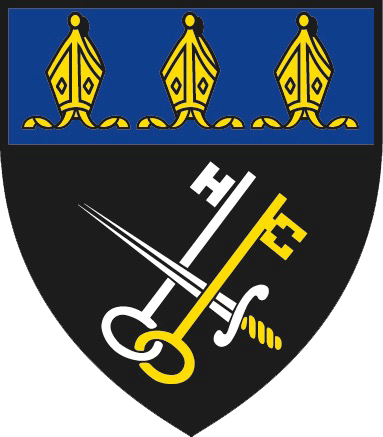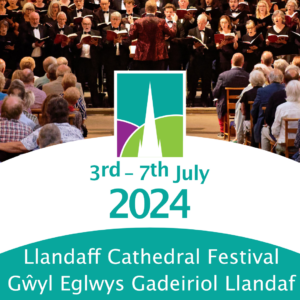The cathedral possesses an impressive collection of early carved effigial monuments. Several of these have been studied and only a summary is given here. For more information, see the references in Further Reading under Rh. Biebrach and M. Gray.
The effigy in a niche in the south aisle is traditionally interpreted as representing Bishop Henry of Abergavenny (d. 1218). Although the plan in Browne Willis’s study of the cathedral published in 1719 is not totally accurate, this effigy may be the ‘Monument of a Bishop defaced’. If so, it was moved later to its present position, as the 1719 plan has it positioned further along the south aisle, to the east of the Chapter House.
Further along the south aisle, and beneath the organ loft staircase, is the very eroded late thirteenth-century semi-effigial slab of Philip Taverner and his wife, its inscription being recorded in a Browne Willis manuscript in the Bodleian Library, Oxford.
At the end of the south aisle, in a recess in the Teilo Chapel is the alabaster figure of a woman, though to be Lady Christian Audley (d. 1409).
Three other 13th century episcopal effigies, but later than Henry’s, traditionally represent the saints Dyfrig, Teilo and Euddogwy. The original position of these figures is uncertain, and a suggestion has even been made that they stood vertically in niches on the west front. The Euddogwy figures lies in the north aisle of the nave, with Teilo resting on the site of his tomb on the south side of the sanctuary, restored by the Victorians. To the left of the bishop’s head is the damaged figures of the Virgin and Child. Below the effigy are scenes from the life of Teilo created by Frank Roper in 1973.
The third bishop, Dyfrig, lies opposite the entrance to the eponymous chapel, originally known as the Mathew chantry chapel. The ‘tomb’ is a mixture taken from two or more monuments that date from the 13th to the 15th centuries. On the Browne Willis plan this tomb is shown as ‘Bishop Bromfield’s monuments as is supposed’. Edmund Bromfield died in 1393 and had been consecrated bishop of Llandaff in January 1390.
There are two interesting features in this tomb. Beneath the arch and positioned as if the figure would be looking up at it is an example of the Image of Pity, the figure of Christ rising from his tomb, and would have been shown with his wounds, if painted originally. On the back wall of the recess is a shield displaying the Instruments of Christ’s Passion, such as the hammer and nails used in the crucifixion.
The Dyfrig Chapel contains three other notable monuments. In the north wall is a cadaver carving, representing the decaying body of whoever was interred here; one of only three such monuments in Wales. Such monuments generally date to the fifteenth and sixteenth centuries, and act as reminder for people to prepare for their own deaths.
Of the three effigies of members of the Mathew family of Llandaff and Radyr, two lie in the Dyfrig Chapel. The single figure is David Mathew, around whom much mythology exists, such as saving the life of King Edward IV at the battle of Towton in 1461. By the 1450s he was well into middle age, and unlikely to have even fought at Towton. Nor is he likely to have been knighted. The effigy originally stood in the north-east corner of the chapel. See also https://www.walesonline.co.uk/lifestyle/nostalgia/welsh-history-month-tomb-david-3406443
The tomb-chest of David’s grandson, Christopher Mathew Esq. (d. after 1531), with his wife, Elizabeth, lies in a recess between the Dyfrig and Lady chapels, and some of the original paintwork survives – most if not all of these figures would have been painted originally. A bedesman in the act of prayer, albeit sleeping, can be seen beneath one of the feet of the male effigy.
The other effigy in the Dyfrig Chapel represents John Marshall, bishop of Llandaff (1478-96), in the position that he stipulated in his will. Whether the chest on which the effigy sits is original or not, an addition to the tomb-chest at one end is another example of the Instruments of Passion.
In the north-east corner of the Lady Chapel is the effigy of William de Braose, bishop of Llandaff (1266-87) and builder of the chapel. It bears the inscription WILLELMUS DE BREWSA EP’S LA’D. The 1719 plan of the cathedral shows the effigy in the position it is today, although at some stage the bishop has lost his feet.
The tomb-chest of the third Mathew monument, that of Sir William (d. 1528) and Lady Jenet, lies by the pulpit in the nave. It is in its original position, judging by the 1719 plan, and was surrounded by rails, but at some stage it was dismantled and kept upright in the Chapter House. William was knighted by King Henry VIII for his role in Henry’s campaign of 1513 in France.
For further information, click the button below




